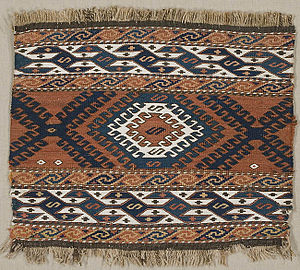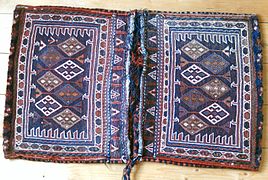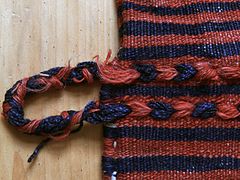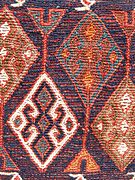A | B | C | D | E | F | G | H | CH | I | J | K | L | M | N | O | P | Q | R | S | T | U | V | W | X | Y | Z | 0 | 1 | 2 | 3 | 4 | 5 | 6 | 7 | 8 | 9

| Part of a series on |
| Islamic culture |
|---|
| Architecture |
| Art |
| Clothing |
| Holidays |
| Literature |
| Music |
| Theatre |
Soumak (also spelled soumakh, sumak, sumac, or soumac) is a tapestry technique of weaving sturdy, decorative fabrics used for carpets, rugs, domestic bags and bedding, with soumak fabrics used for bedding known as soumak mafrash.
Soumak is a type of flat weave, somewhat resembling kilim, but with a stronger and thicker weave, a smooth front face and a ragged back, where kilim is smooth on both sides. Soumak lacks the slits characteristic of kilim, as it is usually woven with supplementary weft threads as continuous supports.
The technique involves wrapping coloured weft threads over and under the warp threads, adding strength and embroidery-like pattern.
Etymology
The name 'soumak' may plausibly derive from the old town of Shemakja in Azerbaijan, once a major trading centre in the Eastern Caucasus.[1] Other theories include an etymology from Turkish 'sekmek', 'to skip up and down', meaning the process of weaving; or from any of about 35 species of flowering plant in the Anacardiaceae or sumac family, such as dyer's sumach (Cotinus coggygria), used to make dyestuffs.[2] If this last is the source of the name, then it is derived from the Arabic and Syriac word 'summāq', meaning 'red'.[3]
Technique

The technique of making a soumak involves wrapping wefts over a certain number of warps (usually 4) before drawing them back under the last two warps. The process is repeated from selvedge to selvedge. The wefts are discontinuous; the weaver selects coloured threads in turn, and wraps each within the area which is to have that particular colour. Unlike kilim, the back is left ragged, with all the loose ends of the differently-coloured weft threads visible, sometimes several inches long, providing extra thickness and warmth. Also unlike kilim, there are no slits where colours meet, as there is a supplementary or structural weft which supports the coloured pattern weft. Some late Soumaks made by the Kurds are however "weftless", lacking the structural weft support, and the stitches naturally overlap.[2][4][5][6][7]
Soumaks tend to be finely woven, and although not as durable as piled carpets, they are stronger than kilims. The soumak wrapping often covers the whole surface of a bag or rug, but it can equally be applied in decorative strips, contrasting with the plainer and thinner flatweave areas.[4][8] For example, camel bags from Malatya in Eastern Turkey could be woven in simple flatweave stripes of red and blue, with broad strips of soumak weft-wrapping with motifs for fertility and protection.[9]
Bags were sometimes woven with a face of soumak, with a tapestry-woven kilim-like top creating slits between blocks of colour: a rope was threaded in and out of the series of slits to fasten and close the bag.[10] Sizes vary, from carpet format through bags for bedding or for use on pack animals, to tiny tribal domestic bags.[4][8] The following images show the appearance and construction of just such a soumak saddle bag, woven in Luristan at the end of the 20th century. The Lurs sometimes, as here, combine soumak and knotted carpet piling to adorn a single piece.[11] To form the motifs, the weaver may push the weft threads about to form curves or slanting shapes as desired.[4]
- Soumak saddle bag, Luristan, late 20th century
-
Front
-
Detail of woollen handle
-
Simple red and blue striped rear, without weft wrapping
-
Detail of weft wrapping: "weft yarns .. can be pushed about as the weaver wishes"[4]
-
Detail of motif on front
-
Detail of decorative border, with slits for rope to close and secure bag
-
Saddle bag shown open one side
-
Detail of edge with narrow strip of pile carpet
-
Detail of reverse showing ragged ends of weft threads of different colours
Regions
Soumak products are made in the Caucasus (especially the Shirvan region), Southern and Western Persia including Luristan, Turkish Anatolia, by the Shahsavan tribe and the Kurds in north-western Persia, and by the Baloch people on the Persia–Afghanistan border.[4][8][2][6][12][13]
References
- ^ "Soumac". Archived from the original on 14 July 2014. Retrieved 10 June 2014.
- ^ a b c Thompson, Jon (1988). Carpets from the Tents, Cottages and Workshops of Asia. Barrie & Jenkins. pp. 78, 167–168. ISBN 0-7126-2501-1.
- ^ Etymology of Sumac at Etymonline.com and also at "Dictionary English Etymology – Origins – A Short Etymological Dictionary of Modern English Routledge 1958, Parridge)". Archived from the original on 2014-10-12. Retrieved 2017-09-15. and . Etymology of Rhus at Quattrocchi, Umberto (2000). CRC World Dictionary of Plant Names: Common Names, Scientific Names, Eponyms, Synonyms, and Etymology. Vol. IV R-Z. Taylor & Francis US. p. 2306. ISBN 978-0-8493-2678-3.
- ^ a b c d e f Mallett, Marla. "Basic Tribal and Village Weaves". Retrieved 24 January 2016.
- ^ Cassin, Jack (1998). "Soumak and Kelim weaving of the Caucasus". Weaving Art Museum. Retrieved 24 January 2016.
- ^ a b Haack, Hermann; Wingfield Digby, George & Cornelia (trans.) (1960). Oriental Rugs: An Illustrated Guide. Faber & Faber. pp. 25–26.
- ^ Wendorf, Michael (November 2000). "The Nature of Kurdishness". Hali. 113: 73.
Kurds also continued to create weavings using simple and ancient techniques such as weft wrapping without intervening ground wefts (weftless soumak), paired warp tapestry, and other techniques long abandoned by other weavers.
- ^ a b c Middleton, Andrew (1996). Rugs & Carpets. Mitchell Beazley. ISBN 9781857326345.
- ^ Gillow, John; Sentance, Bryan (1999). World Textiles. A Visual Guide to Traditional Techniques. Thames and Hudson. pp. 64–65. ISBN 0-500-01950-9.
- ^ "Bag face (T.205-1922)". Victoria and Albert Museum. Retrieved 24 January 2016.
- ^ "Luri Rug, South West Persia". Persian Rug Village. Archived from the original on 25 January 2016. Retrieved 25 January 2016.
- ^ O'Connell, Barry. "Fantastic Animal Shahsavan Soumak Bagface 3rd quarter 19th c". Persian Carpet Guide. Archived from the original on 15 February 2014. Retrieved 25 January 2016.
- ^ "Kurd Soumak Bagface Late 19th C". Persian Carpet Guide. Retrieved 25 January 2016.
>Text je dostupný pod licencí Creative Commons Uveďte autora – Zachovejte licenci, případně za dalších podmínek. Podrobnosti naleznete na stránce Podmínky užití.
File:Borchaliu Soumak Mafrash.jpg
Borchali
Kilim motifs
Evil eye
Category:Islam
Islamic culture
Islamic architecture
Architecture of Azerbaijan
Indo-Islamic architecture
Mosque architecture in Indonesia
Moorish architecture
Ottoman architecture
Iranian architecture
Somali architecture
Sudano-Sahelian architecture
Tatar mosque
Swahili architecture
Architecture of Yemen
Islamic art
Arabian carpet
Azerbaijani rug
Batik
Islamic calligraphy
Damask
Islamic embroidery
Ikat
Iznik pottery
Khatam
Kilim
Islamic art#Painting
Oriental rug
Paan dan
Persian carpet
Suzani (textile)
Tapis (Indonesian weaving style)
Turkmen rug
Anatolian rug
Zardozi
Islamic clothing
Abaya
Agal (accessory)
Boubou (clothing)
Burqa
Chador
Hijab
Headscarf
Jilbāb
Jellabiya
Kaftan
Kameez
Keffiyeh
Kupiah
Niqāb
Salwar
Songkok
Taqiyah (cap)
Thawb
Islamic holidays
Arba'een
Eid al-Ghadir
Chaand Raat
Eid al-Fitr
Eid al-Adha
Imamat Day
Islamic New Year
Laylat al-Qadr
Mawlid
Ramadan
Laylat al Bara'at
Laylat al-Raghaib
Islamic literature
Arabic literature
Azerbaijani literature
Bengali literature
Crimean Tatar literature
Gambian literature
Hausa literature
Indonesian literature
Javanese literature
Literature of Kashmir
Kazakh literature
Kurdish literature
Kyrgyz literature
Malaysian literature
Malays (ethnic group)#Literature
Malian literature
Nigerian literature
Pashto literature and poetry
Persian literature
Punjabi literature
Sindhi literature
Somali literature
South Asian literature
Tajik literature
Tatar literature
Turkish literature
Turkmen literature
Urdu literature
Uyghur literature
Uzbek literature
Islamic music
Ashik
Daf
Dastgah
Gamelan
Gendang beleq
Ghazal
Haḍra
Hamd
Jarigan
Madih nabawi
Mappila songs
Arabic maqam
Mugham
Naʽat
Nasheed
Noha
Qawwali
Sufi music
Talempong
Tambourine
Islamic theatre
Bangsawan
Cem (Alevism)
Karagöz and Hacivat
Sama (Sufism)
Ta'zieh
Wayang
Portal:Islam
Template:Islamic culture
Template talk:Islamic culture
Special:EditPage/Template:Islamic culture
Tapestry
Oriental rug
Kilim
Weft
Embroidery
Shemakja
Azerbaijan
Anacardiaceae
Sumac
Dyer's sumach
Syriac language
File:Soumak weave.jpg
Weft
Weft
Warp (weaving)
Selvedge
Carpet
Kilim
Malatya
Kilim motifs
Tapestry
Pack animal
Saddle bag
Luristan
Saddle bag
Luristan
File:Luristan Soumak saddle bag front.JPG
File:Luristan Soumak saddle bag rear detail of handle.JPG
File:Luristan Soumak saddle bag rear.jpg
File:Luristan Soumak detail of weft wrapping.JPG
File:Luristan Soumak saddle bag detail of motif.JPG
File:Soumak saddle bag border with slits for rope.JPG
File:Luristan Soumak saddle bag open.JPG
File:Luristan Soumak bag detail of pile carpet edge.JPG
File:Luristan Soumak saddle bag detail of reverse, threads ragged.jpg
Caucasus
Shirvan
Persia
Luristan
Anatolia
Shahsavan
Kurdish people
Baloch people
Persia
Afghanistan
ISBN (identifier)
Special:BookSources/0-7126-2501-1
ISBN (identifier)
Special:BookSources/978-0-8493-2678-3
ISBN (identifier)
Special:BookSources/9781857326345
ISBN (identifier)
Special:BookSources/0-500-01950-9
Victoria and Albert Museum
Template:Rugs and carpets
Template talk:Rugs and carpets
Special:EditPage/Template:Rugs and carpets
Carpet
Arabian carpet
Afghan rug
Alcaraz rug
Azerbaijani rug
Absheron carpet weaving school
Aghajly
Arraiolos rug
Arran (carpet)
Borchaly (carpet)
Caucasian carpets and rugs
Chul (carpet)
Demirchilar (carpet)
Ganja rugs
Gasimushaghi carpets
Jek carpets
Karabakh carpet
Kilim
Quba rugs and carpets
Shabalyt buta carpet
Shedde
Bessarabian rugs and carpets
Braided rug
Catalogne (rug)
Chobi rug
Dhurrie
Flokati rug
Kashmiri rug
Lilihan carpets and rugs
Mughal carpets
Navajo weaving
Oriental rug
Pakistani rug
Petate
Persian carpet
Abadeh rug
Ahar rug
Arak rug
Ardabil rug
Bakhtiari rug
Bakshaish
Bidjar rug
Borujerd rug
Gabbeh
Heriz rug
Isfahan rug
Jozan rug
Karadagh rug
Kashan rug
Kashmar carpet
Kerman carpet
Kilim
Kurdish rugs
Mashhad rug
Nain rug
Qom rug
Sarouk Persian carpets
Seraband rug
Shahsevan rug
Shiraz rug
Tabriz rug
Varamin carpet
Zanjan rug
Rya (rug)
Scandinavian rugs
Seychour Rugs
Tibetan rug
Turkmen rug
Uzbek carpet
Uzbek Julkhyr
Uzbek Napramach
Yürük rug
Arabian carpet
Armenian carpet
Axminster carpet
Oriental carpets in Renaissance painting#Bellini carpets
Berber carpet
Bergama carpet
Bessarabian rugs and carpets
Bradford carpet
Caucasian carpets and rugs
Chiprovtsi kilim
Crivelli carpet
Ersari carpet
Fitted carpet
Gabbeh
Hereke carpet
Karabakh carpet
Konya carpets
Holbein carpet
Lilihan carpets and rugs
Lotto carpet
Memling carpet
Milas carpet
Persian carpet
Pirot carpet
Quba rugs and carpets
Sarouk Persian carpets
Swedish carpets and rugs
Turkish carpet
Ushak carpet
Yomut carpet
James F. Ballard
Francis Crossley
Kurt Erdmann
Arthur T. Gregorian
Arshag Karagheusian
Latif Karimov
Julius Lessing
William Morris
George Hewitt Myers
Arthur Upham Pope
Alois Riegl
Friedrich Sarre
Wilhelm von Bode
Thomas Whitty
Charles Yerkes
Azerbaijan Carpet Museum
Carpet Museum of Iran
Dar al Athar al Islamiyyah
Brukenthal National Museum
Kidderminster carpet industry
Louvre
Mevlana Museum
Metropolitan Museum of Art
Miho Museum
Museum of Applied Arts (Budapest)
Museum of Applied Arts, Vienna
Museum of Islamic Art, Doha
Updating...x
Text je dostupný za podmienok Creative
Commons Attribution/Share-Alike License 3.0 Unported; prípadne za ďalších
podmienok.
Podrobnejšie informácie nájdete na stránke Podmienky
použitia.











